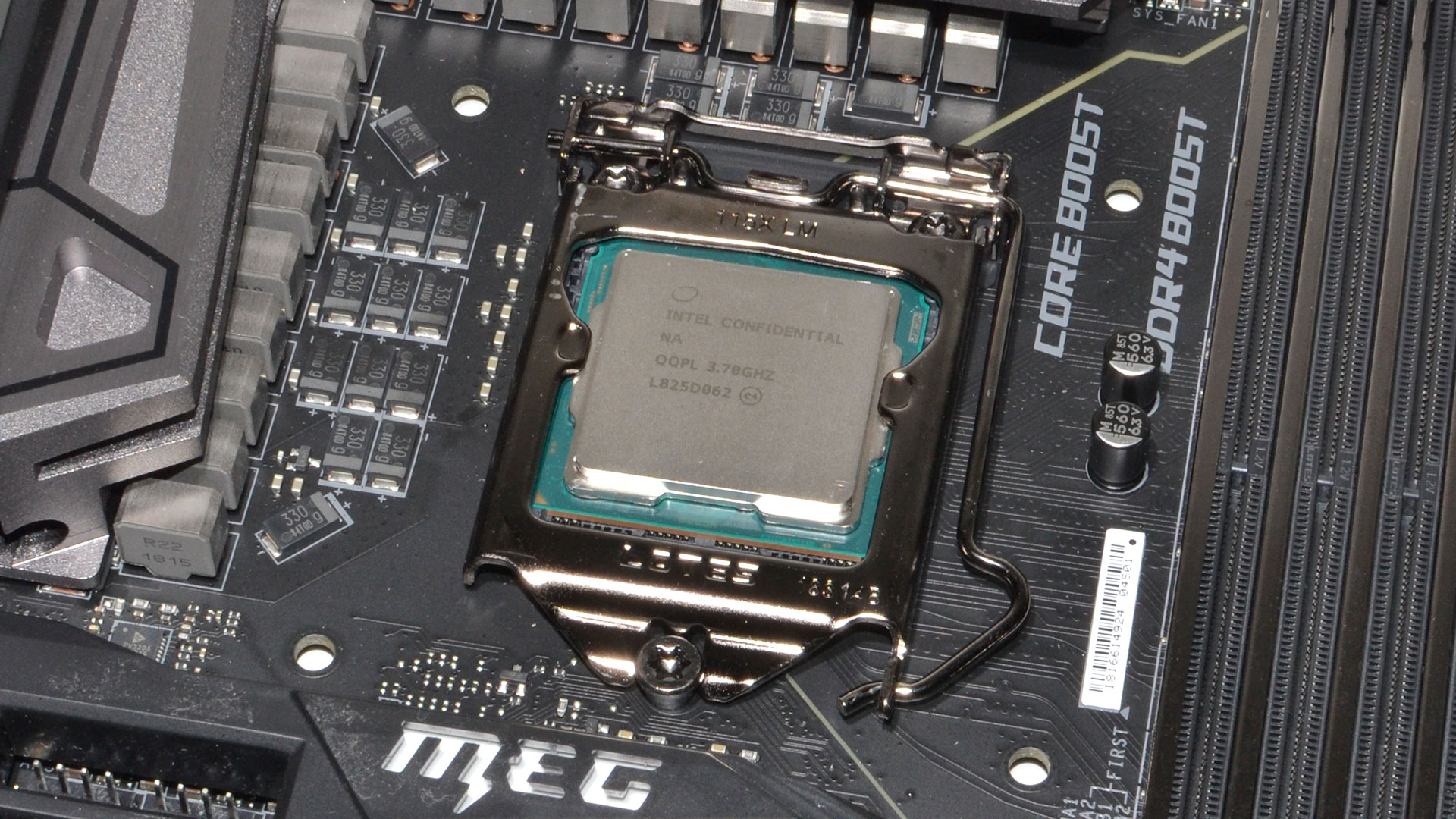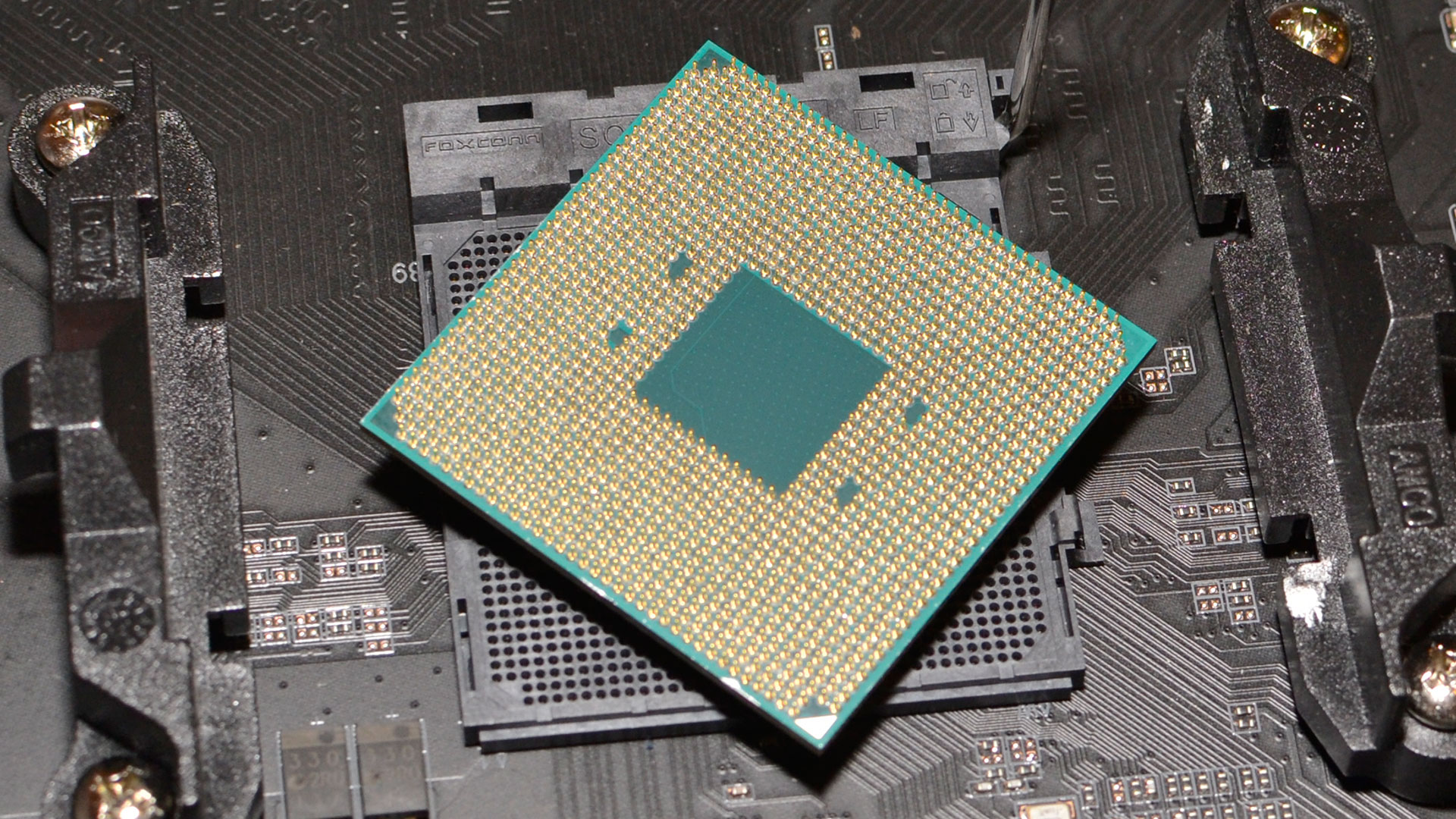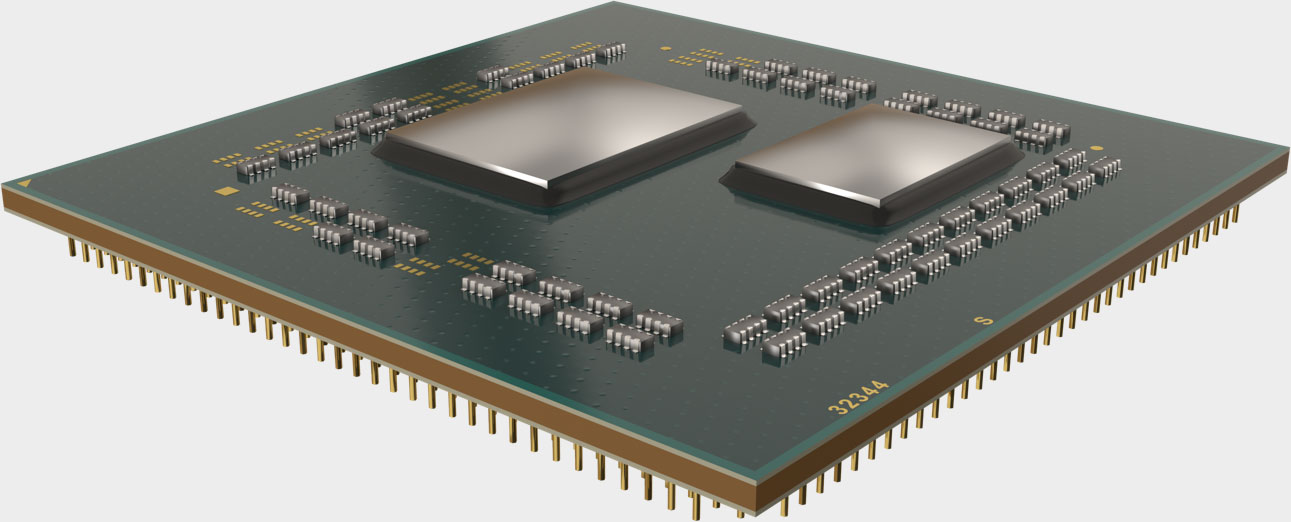The competition between AMD and Intel CPUs has been going on for decades. Most of that time, Intel has held the lead, but I’m not concerned so much with the past. Here’s the current state of AMD and Intel CPUs, what are the pros and cons of each, and everything else you really need to know about the great CPU debate. And if you’re wondering which one to buy, check our guide to the best CPUs for gaming.
Note that for this article, I’m focusing primarily on mainstream desktop CPUs. Both AMD and Intel offer a variety of processors, including mobile and server solutions. The mobile chips are often similar to the desktop parts, only with lower clockspeeds and power use, while server and workstation solutions generally cost a lot more and aren’t really necessary for most consumers any longer.

Intel 8th and 9th Gen CPUs
The fastest gaming CPUs right now are Intel’s latest (8th and 9th) generation CPUs (codename Coffee Lake). The first 8th Gen parts came out in late 2017, while the first 9th Gen CPUs arrived one year later in October 2018. All the 8th and 9th Gen (desktop) CPUs run in socket LGA1151 motherboards with 300-series chipsets. (That’s not to be confused with LGA1151 motherboards with 100-series or 200-series chipsets, as those are for 6th and 7th Gen Intel processors.)
Intel’s CPUs tend to be bespoke designs, adding cores in pairs with 4MB or 3MB L3 cache per pair (1MB can be disabled). Intel also disables Hyper-Threading support (two threads per core) on many of its processors. Major desktop CPUs from Intel right now consist of the following, though there are many others we’re not including here:
Clockspeed for Intel CPUs can vary quite a bit, with base clocks as low as 3.6GHz and turbo clocks as high as 5.0GHz. While that might seem like a huge range, many enthusiast motherboards will run the 8th and 9th Gen CPUs at speeds much closer to the maximum turbo clock—so the i9-9900K for example typically runs at 4.7-5.0GHz in my test PC. Only the K-suffix Intel processors are unlocked, so if you don’t get a part ending with a K (or KF), you can’t overclock at all. The K-series Intel CPUs also come without a heatsink, so you’ll need to provide one—and typically, you’ll want a good liquid cooling solution for the 6-core and 8-core models.

Intel typically only supports one or two generations of CPU on its motherboards, sockets, and chipsets. The 8th and 9th Gen CPUs work in the same boards (though not all boards can support the i9-9900K), but I don’t expect Intel’s future 10th Gen (or whatever comes next) CPUs to run in today’s motherboards. Intel’s current 300-series chipsets consist (in terms of decreasing features) of the Z390, Z370, H370, B360, B365, Q370, and H310. Only the Z390 and Z370 support overclocking, including running system RAM at higher than spec clocks, so we largely recommend the Z-series boards. If you don’t care about overclocking, I’d stick to the H370 chipset as the other chipsets often cut some useful features.
Intel’s desktop 8th and 9th Gen CPUs come with 16 PCIe lanes, which can interface with either a single x16 slot, two x8 slots, or an x8 slot and two x4 slots. (Deciding which configurations to support is up to the motherboard manufacturer.) The CPU interfaces with the chipset (aka PCH, or Platform Controller Hub) via a DMI 3.0 interface that’s basically the equivalent of an x4 PCIe Gen3 connection.
The Core i5/i7/i9 parts can support up to 128GB of DDR4 (4x32GB), while the Core i3 CPUs support up to 64GB (4x16GB or 2x32GB). Officially, the i5/i7/i9 also support up to DDR4-2666 while the Core i3 stops at DDR4-2400. However, with a Z-series motherboard I have been able to run every Coffee Lake CPU with DDR4-3200 memory without incident.
Besides its mainstream CPUs, Intel’s high-end desktop (HEDT) X299 platform uses socket LGA2066 and supports a different set of Core i7 and Core i9 processors. These have anywhere from 6-core to 18-core designs. The 6-core and 8-core i7 parts have been largely supplanted by the 9th Gen mainstream CPUs, while the 10-core and above cost a lot more and are primarily for workstation use. The X299 CPUs also have higher latency and lower clockspeeds than LGA1151, so for gaming use they’re often slower than the mainstream CPUs and we don’t generally recommend them as ‘superior’ gaming solutions.

AMD Ryzen CPUs
AMD fell way behind in the CPU race during the past decade, but that all changed in 2017 with the introduction of the Ryzen processors. Per-core CPU performance improved by roughly 50 percent over AMD’s previous FX-series parts, and suddenly things became very interesting in the CPU space. Perhaps more importantly, where Intel at the time was pushing 4-core/8-thread CPUs as its fastest mainstream solutions, AMD doubled down and released 8-core/16-thread parts at comparable prices. Intel responded with its 8th and 9th Gen parts, which is where we are now.
AMD Ryzen CPUs have a basic building block called a CCX (Core Complex). In current Ryzen processors, the CCX has four CPU cores and 8MB of shared L3 cache, though that may change with a future version of Ryzen. The most popular Ryzen CPUs have a single die that contains two CCX, while the APUs have a single CCX with 4MB L3 and a Vega GPU core sharing the die. AMD’s Ryzen 7 CPUs are 8-core/16-thread parts, while the Ryzen 5 CPUs disable one (sometimes two) cores per CCX, making them 6-core/12-thread parts. Here’s the short list of AMD’s main second generation Ryzen parts:
Clockspeed for first generation Ryzen tops out at 4GHz, while second generation parts can reach 4.3GHz—those limits are for both stock and overclocked operation, in my experience. All AMD Ryzen CPUs are also unlocked, meaning you can try overclocking them. I’ve had only limited success with improving performance on the top X-suffix parts, as they’re normally running very close to maximum performance even without overclocking. The non-X models however tend to be better, with overclocks of 200-400MHz being typical (depending on the model).

AMD’s primary platform for Ryzen CPUs is socket AM4. Each AM4 CPU uses 1331 pins, about 180 more than Intel’s equivalent socket. Unlike Intel’s recent CPUs, Ryzen CPUs have the pins on the CPU itself rather than in the socket. It’s not a huge difference, but you should exercise care when handling Ryzen CPUs as dropping one can easily bend some pins.
One of the great things about AMD platforms is that AMD typically supports multiple generations of hardware on a single socket. The first and second generation (Ryzen 1000 and Ryzen 2000) CPUs and APUs all work in the same motherboards, and AMD has committed to sticking with socket AM4 at least for the upcoming third generation Ryzen 3000 parts. You’ll need an updated BIOS for any older motherboard, and not all motherboards are guaranteed to work with all third gen CPUs, but it’s nice to not leave behind your motherboard each generation.
Ryzen CPUs require a compatible motherboard—there’s no way to put an AMD CPU in an Intel motherboard or vice versa, just like you can’t put a Ryzen CPU in an older socket AM3+ motherboard. AMD’s main chipsets for the platform, in terms of features, consist of the X470, B450, X370, B350, A320, X300, and A300. Unless you already own a compatible motherboard, generally speaking the X470 and B450 are the ones you’ll want—they’re slightly enhanced versions of the X370 and B350.
Each Ryzen CPU has a total of 24 PCIe lanes that interface to other components. Four of these link the CPU and chipset, and four more are for a dedicated M.2 NVMe slot for the new (and fast) NVMe SSDs—that’s part of why AM4 has more pins than Intel’s LGA1151. The remaining 16 lanes are for either a single x16 slot for graphics, or on X-series chipsets there’s an option for dual x8 connections for multiple graphics cards. Ryzen APUs meanwhile use eight lanes internally to link the CPU and the GPU, so they only support a single x8 connection for dedicated graphics cards.
Officially, AMD’s first generation Ryzen 1000 CPUs support up to DDR4-2666 memory clocks. The second generations Ryzen 2000 parts support up to DDR4-2933. It’s possible to run memory at higher clockspeeds, but the achievable speed varies by CPU and motherboard. Many X470 boards can do DDR4-3200 and more with a Ryzen 7 2700X, but I’ve encountered issues at times with Ryzen 5 CPUs. Officially, all Ryzen CPUs at present support a maximum of 64GB (4x16GB) memory.
AMD also has higher performance Ryzen Threadripper CPUs that put two or four 8-core chips inside a single package, providing 12-core, 16-core, 24-core, and 32-core CPUs—with twice as many threads as cores in each case. While these can be very fast for professional application workloads, Threadripper CPUs don’t work in AM4 motherboards. Instead, you’ll need a socket TR4 motherboard. Rather than looking at Threadripper, however, it would be better to keep an eye on the Ryzen 3000 parts. Those will likely arrive in June or July and will feature up to 16-core/32-thread CPUs for socket AM4.

How AMD and Intel differ in performance
For many users, the difference between any of the current generation AMD and Intel CPUs is negligible. All of them can surf the Internet, stream Netflix, run office applications, multitask between all of those, and more. The only way to really uncover differences is to run demanding workloads, which we do for our CPU reviews.
For multithreaded application workloads, the Ryzen 7 2700X trades blows with the Core i7-8700K and Core i7-9700K—it’s a tad slower, but also costs quite a bit less. Most users would likely never notice the difference. Intel’s 9900K might be 25 percent faster than the 2700X, but only when you’re really hitting the CPU hard.
Shift over to games, and differences can become more noticeable. With a high-end GPU like an RTX 2080 or RTX 2080 Ti, the fastest Intel CPUs typically lead AMD’s best Ryzen parts by 15 percent, and in some games the gap can be as large as 25 percent. The gap shrinks at 1440p and 4K, but it’s also worth noting that quite a few games fail to hit 144fps (eg, for a 144Hz monitor) with Ryzen CPUs, regardless of resolution or setting.
Part of the reason AMD CPUs are a bit slower in games is that games don’t usually make use of more than four to six CPU cores, so the extra cores on Ryzen CPUs are often idle. That may change in the coming years, but the other part of the equation is latency—the time to access and process data. AMD’s dual-CCX design has higher cache and memory latency than Intel’s 6-core and 8-core parts, leading to slightly worse overall performance in latency sensitive workloads like games. Incidentally, that same latency problem exists with both Threadripper and Intel’s X299 parts: worse latency and worse gaming performance than the i7-8700K.

Final thoughts on AMD vs. Intel CPUs
In terms of value, it’s easy to make the case for AMD’s Ryzen CPUs. You can get an 8-core/16-thread Ryzen 7 CPU starting at just $160, and that includes a cooler that works well with the CPU. Step down to 6-core/12-thread Ryzen 5 and they start as low as $120. AMD also makes budget-friendly APUs—a 4-core CPU combined with a modest integrated graphics solution that’s typically twice as fast as Intel’s current integrated graphics. For each category, Intel’s equivalent CPUs cost anywhere from $25 to $300 more—a budget Core i3 won’t cost that much more than a Ryzen 3 APU, but the high-end Core i9-9900K costs substantially more than the Ryzen 7 2700X.
Intel CPUs are typically the favorite choice for performance and overclocking enthusiasts. While the overclocking range for the latest 8-core parts is limited (4.9-5.1GHz being the typical maximum without exotic cooling solutions), the 8th Gen parts hit similar overclocks but start at lower base clocks. Intel’s top CPUs cost more than their AMD counterparts, especially once you add in a decent cooler, but they’re also faster. AMD has nothing that can beat the Core i9-9900K, in games or other applications.
But how much are you willing to pay for the final boost in performance that Intel offers? And are you willing to wait for AMD’s upcoming Ryzen 3000, which may close the gap with the 9900K? For multithreaded workloads (eg, video editing and encoding), AMD’s Ryzen CPUs are very competitive. I’d also be remiss if I didn’t point out how long Intel sat at 4-core/8-thread mainstream desktop CPUs. It’s mostly thanks to AMD and it’s Ryzen processors that Intel has started shipping 6-core and 8-core CPUs at far more reasonable prices.
Right now, the competition for CPU dominance between AMD and Intel is closer than we’ve seen since the first Athlon 64 parts in 2003. AMD hasn’t held the performance crown since 2006—not in every meaningful category at least—but with 7nm Ryzen 3000 CPUs coming this summer, and Intel still stuck at 14nm with Coffee Lake, this year is perhaps AMD’s best shot at the title.
